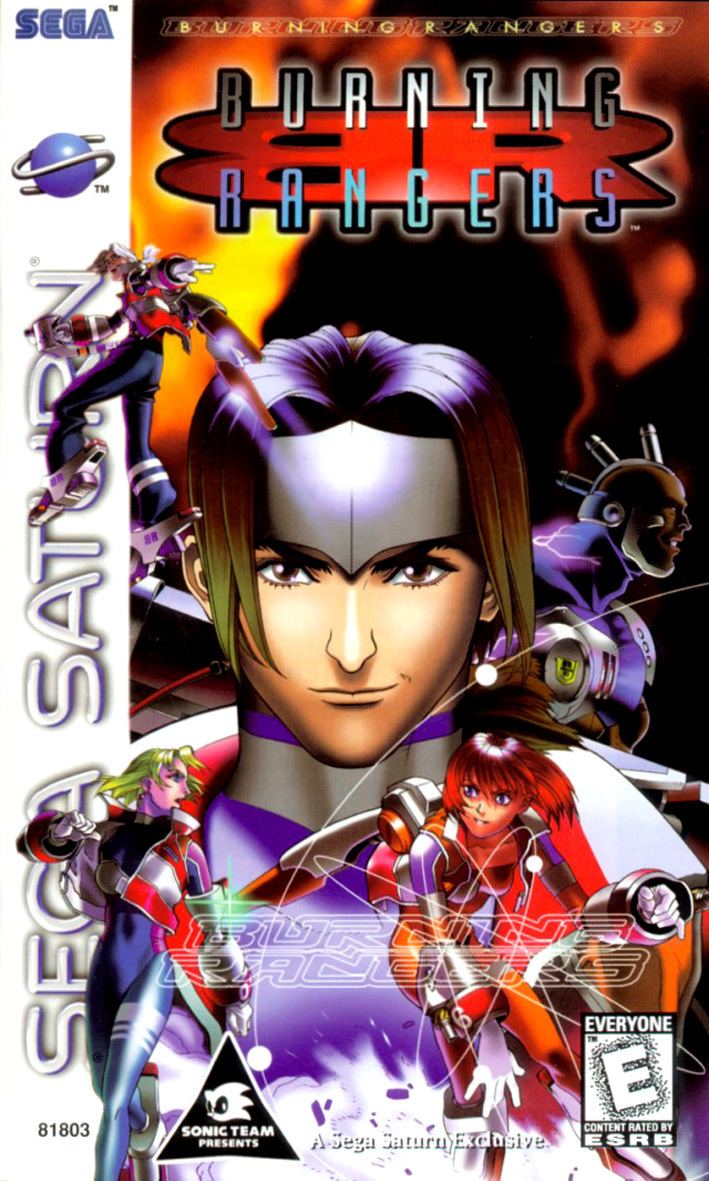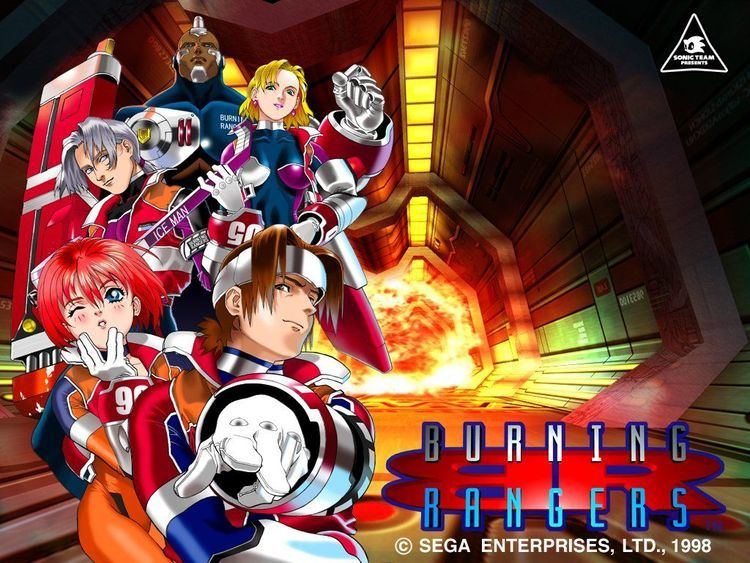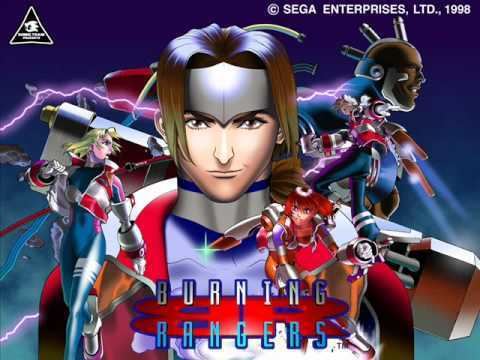8.6 /10 1 Votes
8/10 IGN | 4.3/5 Emuparadise 4.6/5 CoolROM Initial release date 26 February 1998 Publisher Sega | |||||||||||||||||||||||||||||||||
 | ||||||||||||||||||||||||||||||||||
Artist(s) Naoto OhshimaHideaki MoriyaKosei Kitamura Composer(s) Naofumi HatayaFumie KumataniMasaru Setsumaru Release date(s) JP: 26 February 1998NA: 31 May 1998EU: 16 June 1998 Genres Action game, Third-person shooter Similar Sonic Team games, Platform games | ||||||||||||||||||||||||||||||||||
Burning rangers review for the sega saturn
Burning Rangers (Japanese: バーニングレンジャー, Hepburn: Bāningu Renjā) is an action video game developed by Sonic Team and published by Sega for the Sega Saturn. It was released in Japan in February 1998, and later that year in North America in May and in Europe in June. Burning Rangers is set in a futuristic society in which fire is the remaining danger. Players control one of an elite group of firefighters, the Burning Rangers, who extinguish fires and rescue civilians in burning buildings. Most of the tasks the players complete are centred around collecting energy crystals to transport civilians to safety. In lieu of an in-game map, Burning Rangers features a voice navigation system which directs players through corridors.
Contents
- Burning rangers review for the sega saturn
- Burning rangers saturn by sega a rank hd 1080p
- Gameplay
- Conceptualisation and planning
- Design
- Reception
- References
Development began shortly after the release of Christmas Nights in November 1996. Producer Yuji Naka wanted to create a game which involved saving people rather than killing them. Sonic Team chose to connect the game with firefighting as they thought it was an effective way of having players identify with heroism. Burning Rangers received mostly positive reviews. Critics unanimously commended the game's soundtrack and audio, with the voice navigation system receiving particular praise. The response to the graphics was mixed, with some critics asserting that it had the best visuals on the Saturn, although it was noted for its poor collision detection and occasional glitching. The game was among the final five Saturn titles released in America.

Burning rangers saturn by sega a rank hd 1080p
Gameplay

Burning Rangers is a third-person shooter game in which players complete missions involving extinguishing fires and rescuing civilians. The game is set in a futuristic society in which fire is the only danger, and stars an elite group of firefighters, the Burning Rangers. The player assumes control of one of two apprentice rangers, and completes tasks across the game's four levels. The primary objective is to transport stranded civilians from burning buildings, by collecting energy crystals dropped from extinguished fires. A minimum of five crystals are needed to transport a civilian to safety; the player receives an energy shield if they use ten. The crystals function similarly to rings in Sonic the Hedgehog games: possessing at least one crystal allows a player to survive damage from an enemy or fire. Being hit once scatters the player's crystals and renders them vulnerable to death.

The game's four stages take place in power plants, flats, underwater habitats, and space stations in zero gravity, respectively. Every level is an interior space, and consists of multi-storey rooms and corridors divided by interlocking lifts and doors. The player is equipped with a jet pack to reach higher areas and perform acrobatic manoeuvres such as backflips and rolls. They can also swim and dive underwater. Robots attack the player with shooting flames should they come into contact. Each stage ends with a boss battle, ranging from fire-breathing flowers to robotic fish.

Since there is no in-game map, the player character relies on a voice navigation system to find their way. The mission controller gives the player directions depending on their location, which can be repeated at any time. At the end of each stage, the player receives a rank based on their score and success at putting out fires, with "S" the highest and "D" the lowest. Once the game is completed, a random generator mode is unlocked which mixes up the order of corridors in the game's four stages, with a potential total of 3,125 unique routes.
Conceptualisation and planning

Development of Burning Rangers started around November 1996, after the release of Sonic Team's previous game Christmas Nights (a Christmas-themed demo for Nights into Dreams...). The concept originated with the idea of rescuing people as opposed to killing them, which was an element that producer Yuji Naka felt was too common in contemporary video games. The development team of 31 (out of Sonic Team's staff of about 50) was directed by Naoto Ohshima, the director and lead designer Takao Miyoshi. The rest of the team consisted of three game planners, six programmers, eighteen designers, and two sound producers, most of whom had worked on Nights into Dreams....
The team chose to centre the game on firefighters as they felt that fire was the most appropriate way to create fear and tension. In a retrospective interview, Ohshima said that many of the things done by firefighters—along with rescuing people—were "the very essence of a Sonic Team game", and that they recognised that a firefighter was a hero with whom people could identify. The team wanted to make a game with a rescue theme as Naka thought there were few games based on that concept. According to Takeo Miyoshi, "Our first inspiration came from the explosion and building destruction scenes of Hollywood movies. We just wanted to describe the heroism of lifesaving in that loud, explosive type of setting." The developers wanted to design a future that was "clean and beautiful", with sustainable energy, but where disasters still could occur, and only heroes could protect people from them. The designers envisioned that a futuristic firefighter would be acrobatic and dexterous to reach places where people were trapped.
Although the target audience of Burning Rangers was people who enjoyed action games, the developers also wanted to attract fans of other Sonic Team games. Ohshima stressed that he was aiming at a wider audience and not the type of person who only played Sonic the Hedgehog, adding that "players should recognise the Sonic Team touch immediately" with Burning Rangers. The working title was Firefighter, but it was dropped as the team wanted a "cooler" sounding name. Naka felt that "burning" had a "go for it!" connotation in Japanese, and fit with the disaster-rescue theme. He was initially unsure about having "ranger" in the title as he felt that a ranger referred to park rangers in western culture. The team thought that the image of a "ranger" also brought to mind the Power Rangers franchise, and after consulting speakers of other languages, Burning Rangers was chosen as the game's name.
Design
During the early stages of development, some members of Sonic Team visited Hong Kong shortly before the transfer of British sovereignty, in hopes of finding inspiration for the game's stages. Some staff also travelled to Universal Studios in California to experience the Backdraft attraction to learn how to generate a similar sensation in the game. The team also visited a special firefighting event in Tokyo where they witnessed robots putting out fires, and were surprised to see how it compared to their image of the game's futuristic setting. Naka recalled that the robot had special infrared sensors and a camera which could see through fires, and was impressed by their techniques. According to Naka, the team did not ask for advice from professional firefighters during development, partly due to the concern that their game would not be well received, as Naka thought they would have said that real firefighting "wasn't that simple". At the Tokyo Games Show, a real firefighter, however, did comment that the character's costumes were too thin. Naka reflected that if they had made any of game elements highly realistic, the contrast between those elements and the clearly fictional elements would have been exaggerated.
The game uses the same engine as Nights into Dreams.... When Sonic Team developed Nights into Dreams..., they were new to programming for the Sega Saturn, and when the engine was re-used for Burning Rangers they were able to make it faster and more capable. To design the stages and environments, Miyoshi outlined the corridors first, then placed fires in them before adding light effects to simulate the appearance of fire. Miyoshi thought that the team had over-reached in designing the game's detailed stages, saying: "everyone in the team wanted to put so much into the game that we only completed about half of what we wanted to do." Naka said that although they designed only four stages, they ensured that the player's experience would increase progressively throughout the game because each stage was very large. The developers initially used motion capture technology to capture data for poses and animation, but Naka soon discovered that it was impossible to get the results the team wanted, as it was unfeasible for people to perform the special motions they needed. The developers resorted to creating the animation by hand, and only used the motion capture data for the player characters' walking animations.
There were many difficulties in developing the game's voice navigation system, as no verbal dialogue had featured in a Sonic Team game before. Naka asserted the team had rethought all ideas of what should be included in the game during development, and the idea of not including any on-screen maps but rather relying on a voice navigation system was "there from the start". The team tested different forms of navigation systems and picked the best. Although they acknowledged that having a voice navigation system would make the use of background music impossible, they realised that it would help create a dramatic atmosphere. Miyoshi thought that the sound effects of fire and walls creaking alone would be enough to produce immersion.
The team originally wanted to record the game in six languages, but found the volume of work too difficult, reverting to English and Japanese instead. Before selecting voice actors, Miyoshi designed the characters and built up a mental image of what they would sound like. Sonic Team hired several voice actors who had appeared in American television programmes. According to Miyoshi, all audio work was re-written several times throughout development; he considered it to have "evolved" alongside the team's production of the game itself.
Designing the game's fire effects proved to be difficult due to the Saturn's rendering limitations. Miyoshi explained that during testing stages, the team spent a lot of time checking how well they would be able to create fires, which was a pivotal aspect of the game. In the first test ROM they produced, Miyoshi discovered that they were able to achieve "some quite beautiful" fire effects by disguising blocky sprites with various degrees of transparency and lighting effects. At the time, few games used polygons in 3D spaces for acrobatic and exploration-orientated gameplay.
Burning Rangers' animated cutscenes were produced by TMS Entertainment, who have also produced the Virtua Fighter anime and the Man of the Year short on Sonic Jam for Sega, as well as cinematic feature films such as Akira and Little Nemo: Adventures in Slumberland. The company produces content for Sega ever since it became subsidised as TMS-Kyokuchi. The game's anime cutscenes were made with digital animation instead of cel shading, as it was easier to develop for CDs. According to Miyoshi, the entire development of the game spanned around a year and a half, although the actual programming took less than a year.
The game was among the final five Saturn titles to be released in America. Each of the main developers reflected on what they were proudest of: Naka expressed relief that Sonic Team were able to "get a good overall balance" for the game, whereas Miyoshi thought that the voice navigation system was the strongest aspect. Main programmer Takuya Matsumoto was delighted to see it released before the Saturn's discontinuation, saying "the fact that we've been able to push the Saturn this far is enough for me to die happy". Burning Rangers was released exactly nine months before the Japanese release of the Dreamcast.
Reception
Reviewers praised Burning Rangers' colourful lighting effects, but criticised its collision detection and occasional graphical glitching. Lee Nutter of the British Sega Saturn Magazine enjoyed the detailed characters and described the lighting effects as excellent, although he, along with IGN's Levi Buchanan, noticed that the visuals had minor problems. Sonia Herranz from Hobby Consolas and Ed Lomas from Computer and Video Games commended the character's designs, colourful lighting and detailed visuals, though Lomas declared that the graphics "[did] often look a mess".
The game's poor collision detection was unanimously criticised by reviewers, and Colin Williamson of AllGame also felt that the game's prominent polygon errors were a problem, though he appreciated the attractive lighting effects. Some critics compared the game's visuals to those of Nights into Dreams.... Ryan MacDonald commented that it had a similar look and feel to that game's 3D environment, and that Burning Rangers' polygonal graphics were "some of the best [he had] ever seen". Mike Weigand from GamePro considered that the majority of the game featured "drab" stage designs, and in a retrospective review GMR's Dave Smith thought that the game "looks like hell" and had not aged as well as Nights into Dreams..., and that its engine could not handle a free-roaming environment without harming its visuals. Weigand felt the game's 3D environment was a mix of both Tomb Raider and Nights into Dreams....
The soundtrack and sound effects received praise, though reviewers recognised that the game lacked music to create tension. Buchanan appreciated that the game contained a few tracks of "excellent" Sega-style music, with his favourite being the theme song. Although Williamson, Weigand, and Nutter noted the lack of in-game music, they lauded the vocal tracks, voice samples, and sound clues. Most reviewers questioned the quality of the dialogue. Weigand felt it was "lame", and Smith said the game contained "some of the worst voice acting ever produced by human lungs". Herranz had difficulty understanding crucial dialogue since the audio was only recorded in English, although she admitted that the voice guidance system was an innovative element. Williamson praised Sega's decision to produce full voiced dialogue as opposed to subtitling original Japanese dialogue, and also praised its "good-to-excellent" English voice acting, though it was "no Shakespeare".
Reviewers had mixed opinions on the control scheme and use of the Saturn 3D controller. Nutter noted that the controls were a mix of those featured in Tomb Raider and Nights into Dreams..., praising the use of the analogue stick to perform complex manoeuvres. A reviewer from the Japanese Sega Saturn Magazine felt the game was more comfortable with an analogue pad as opposed to the default Saturn controller, and Williamson similarly thought the control scheme was "great" when used with an analogue pad. In contrast, Weigand criticised the lack of a custom configuration and described the controls as "squirrelly", even with the analogue controller. A couple of reviewers criticised the game's short length and lack of difficulty. Nutter suggested that accomplished players would have it "clocked" in a couple of days and felt it did not take much effort to complete the four levels, whilst Buchanan said it was "too short for its own good", a problem made worse by its enjoyable gameplay.
